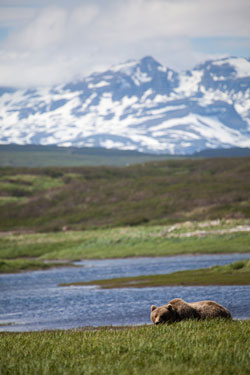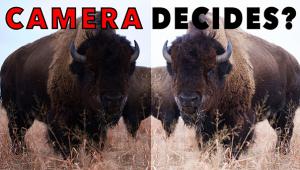Locations: Photographing Bears In Alaska: The McNeil River State Game Sanctuary
Wildlife photographers with any interest in photographing big Alaskan brown bears should certainly consider the McNeil River State Game Sanctuary, professed to have the highest concentration of large adult brown bears in the world with over 70 bears having been seen at any one time. The sanctuary is located on the Alaskan Peninsula about 100 air miles west of Homer and is only reachable by floatplane.

All Photos © Rick Sheremeta
Before you even start packing be aware that you’ll need a permit issued by the State of Alaska Department of Fish and Game. It’s a lottery application process with the application deadline for the upcoming viewing season (June 7th – August 25th) being March 1st. Guided ViewingAccess (“Regular”) Permits are issued in four-day blocks, allowing a maximum of 10 permit holders to go out into the sanctuary to view and/or photograph bears guided by armed Department of Fish and Game personnel. Additionally, three Camp-Standby Viewing Access (“Standby”) Permits are issued that allow holders to stay at the campground/beach area and to fill any vacancies in Regular Permit slots. Although certainly not guaranteed, a good many of the Standby Permit holders get to go on guided trips as well. See the end of this article for more specific information on the sanctuary and permit application process.

What To Expect
There are no lodging accommodations or food services at McNeil. You’ll need to bring everything in with you by floatplane—food, camping equipment, clothing, and camera gear. Weight can be a consideration, and it’s best to consult with the air taxi services when planning your trip. A small camping area is located just off the beach that has level gravel pads to accommodate tents. A cook shack is available for preparing meals (propane is provided) and storing foodstuffs. There is also a wash shack/sauna and the proverbial outhouse. Fresh water can be fetched from a nearby creek for cooking and drinking—you’ll need to bring your own disinfection equipment.
Days in the field are long, lasting anywhere from eight to 10 hours. As there is generally no going back to camp once you set out, you’ll need to bring everything you need for the day—hip boots (preferable) or solid-soled waders are a must, along with extra clothing/rain gear, food, water, and camera gear (more on that later). The day will be spent slogging several miles through muck and tidal flats to reach viewing areas along Mikfik Creek or McNeil River Falls, or both. Weather can be fickle, varying from cold, rainy, and windy to hot, sunny, and dead calm. It’s therefore necessary to come properly prepared. And oh yes, there are mosquitoes—lots of them—especially on hot, calm days.

Photography
While visitors to McNeil come mainly to view and photograph its magnificent bears, other wildlife may occasionally be observed, including moose, caribou, wolves, wolverine, various furbearers, waterfowl, and sea birds. If your interest lies in photographing sows with cubs, this is not the place. Females with young tend to avoid McNeil because of so much competition from large adult bears.
McNeil sports two distinct viewing periods—early and late. The early season is centered along Mikfik Creek and the late season at McNeil River Falls. At each, viewing is different and bears exhibit somewhat different behaviors and activity. It therefore depends on what your interests are when selecting viewing time periods. To help with this, the State website provides data by viewing block dates for locale, number of bears, bear activity, and percentage of permit applicant success.
If you’re more interested in being right in the midst of the bears at eye level, where you can get a good handle on behavior, then Mikfik Creek before July is the place to be. This is still early season on the Alaskan Peninsula and all of the bears may not have arrived for the short sockeye salmon run along Mikfik Creek. However, there are still an ample number of bears to view and photograph and it’s easier to observe individual behavior more closely as things are less chaotic than at McNeil River Falls, where there may be scores of bears all around all at once. At Mikfik, there’s a lot of fishing activity both along the Creek and Upper/Lower Mikfik Falls, mating rituals are common, as is associated competition for mates, and establishment of local dominance among the newly arrived adult bears.

Salmon Run
Bear activity at McNeil River Falls starts in early July as dog salmon (chum) begin their spawn, after the sockeye run plays out at Mikfik Creek. Activity there continues through the end of August. If you want to see lots of big bears all at one time then this is the time and place for you. Bear activity mainly consists of fishing, napping with some play, and aggressive behavior tossed in just to keep things interesting—at times it can be pure chaos. Viewing is done from a two-tiered rock bench just above the Falls where you will be perched much of the day. Although most of the activity is below at the Falls, bears frequently move to and from the river passing close by so there is ample opportunity for close-ups.

Photo Gear
My recommendation would be to leave your big heavy glass at home—you’ll find that it’ll not only be awkward to carry but will also be way more lens than you’ll need. I prefer to travel as light as possible and try to make do with just two lenses—wide-angle and telephoto zooms. I’ve visited the sanctuary on two occasions, doing both Mikfik Creek and McNeil River Falls. After trying a variety of lenses, I’ve come to rely solely on my Tamron 24-70mm f/2.8 zoom and my trusty Canon EF 100-400mm f/4.5-5.6L IS USM telephoto zoom, the latter being more than ample for close-ups, since the subject bears are most often very close. As for a body, I use the Canon EOS 5D Mark II. A polarizer, for the wide-angle zoom, may be of help for scenic shots, but I don’t recommend one on telephoto lenses when fast shutter speeds are key.
Don’t forget a good sturdy tripod. Although many circumstances required shots to be taken handheld, much of the time was spent either sitting or kneeling where a tripod proved invaluable. A rain cover and some plastic garbage bags are absolutely necessary to protect your gear from weather, which can change in a heartbeat in Alaska. Your gear bag needs to be comfortable and with enough capacity to manage not only your photo gear but rain gear, extra clothing, water, and food for the day. My bag of choice on my latest trip was the Lowepro Rover Pro 45L AW, which I found to be both ample for my gear and comfortable to carry all day.

When I’m working the field on a trip like this, I’ll rely mainly on Shutter Priority mode, typically using a minimum shutter speed of 1/1000 sec, or faster, in order to catch all the action. On occasion, when taking a scenic shot, I’ll switch to Aperture Priority mode, and vary the aperture depending on how I want my background to be rendered and where my subject is in relation to the background—f/16 when great depth of field is needed, or f/8 for best image quality and/or when the subject is far away from my camera.
Regardless of when you go to McNeil, it will be an experience that you will remember and cherish for a lifetime. The rush from being close to so many large bears and being able to observe their natural behavior for long periods of uninterrupted time is truly exciting.

Information And Permits
For more specific information on the McNeil River State Game Sanctuary, including the permitting process and available air taxi service providers contact:
Alaska Dept. of Fish and Game
Division of Wildlife Conservation
Attn: McNeil River State Game Sanctuary
333 Raspberry Road
Anchorage, AK 99518-1599
(907) 267-2253
e-mail: dfg.dwc.mcneil-info@alaska.gov
website: www.adfg.alaska.gov/index.cfm?adfg=viewingpermits.mcneil
For more on Rick Sheremeta, including his workshops, please visit www.alpenglowproductions.com.
- Log in or register to post comments
















































